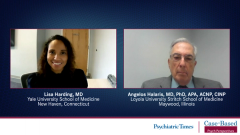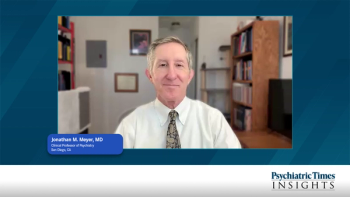
Phase 3 TRANSFORM Trial
Drs Harding and Halaris evaluate the phase 3 TRANSFORM trial that studied intranasal esketamine as a therapy option for treatment resistant depression.
Episodes in this series

Lisa Harding, MD: You mentioned before that you were on the clinical trials for intranasal esketamine. I wanted to talk about the TRANSFORM trial. As you know, the objective of TRANSFORM is that the STAR*D clinical trial showed that a third of our patients don’t respond adequately. This trial is a phase 3 double-blind active control multicenter study that was basically comparing the primary efficacy end point from baseline up to 28 days of patients who were flexibly dosed with esketamine plus a newly initiated antidepressant or the newly initiated antidepressant plus a placebo nasal spray. I wanted to ask you specifically if you had any comments on the efficacy or the safety that came out of this trial.
Angelos Halaris, MD, PhD, APA, ACNP, CINP: Good question. There are many published reports about intranasal esketamine. Most of them were pertaining to the phase 3 clinical trials, including a geriatric study that’s part of the TRANSFORM-3 clinical trial. Frankly, the results are mixed, as presented in the literature. I have at least 2 comments to make about that. Initially, ketamine in general and by extension intranasal esketamine were presented for whatever reasons as panaceas; that they would be the miracle drug that works after a single administration. Those are false hopes. But yes, there’s response.
Lisa Harding, MD: I agree with you, Angelos. Because the very definition of MDD [major depressive disorder] is that it’s a chronic illness. I tell my patients that just like diabetes, where you’re on insulin for life, literature has taught us over the years that major depressive disorders are chronic illness. It’s really interesting that you highlighted the point that the 2 patients whom you’ll be treating today are in the maintenance phase. This is not a cure, so thank you so much for highlighting that.
Angelos Halaris, MD, PhD, APA, ACNP, CINP: The other issue is that 4 weeks is inadequate. Most of these trials were 4 weeks long, twice a week for the first weeks. This is how the FDA approved it, suggesting for the marketed product twice a week for the first 4 weeks, then once a week for weeks 5 to 8, and then thereafter at the discretion of the physician. I understand. I try to abide by it. But once a product becomes widely available, invariably, we gather different data and impressions based on actual experience. I may call it real-life experience rather than the laboratory-based during a clinical trial, if you allow me the expression. I’m not being critical about it. I understand clinical trials. I’ve done them throughout my entire career. That’s what a clinical trial is supposed to be. But allow for the experience of the practitioners once the product is on the market.
Based on my experience and that of some of my colleagues, esketamine needs longer exposure. In some cases, in my practice, I’ve gone beyond 4 weeks of twice-a-week treatments until I was satisfied that I was getting a sustained good response. Then I gradually reduced the frequency.
Lisa Harding, MD: I agree with you 100%. My comment isn’t pejorative on clinical trials either, but we get these cookie-cutter patients who don’t represent the patients who walk into my office every day. Also, remember that in a clinical trial setting, patients are being attended to twice a week for 4 weeks by a great clinical team. You get a psychiatrist and a psychotherapist. They’re called. They have unscheduled visits. It’s true not only for the intranasal esketamine. For most drugs postmarketing, you’ll find that that efficacy drops because it becomes more like real-world data.
Dr Halaris, in your screenings of these patients, who are the patients you find would most benefit from this esketamine therapy? Are there any contraindications to esketamine?
Angelos Halaris, MD, PhD, APA, ACNP, CINP: Once the work-up has been completed, as I outlined earlier, and we’ve ruled out patients as far as ancillary conditions, laboratories, pharmacogenomic testing that I described earlier, then the patient as of then must be on an oral antidepressant concomitantly. I prefer to start the antidepressant, whether it’s new or replacing an older one, based on the pharmacogenomic testing. I’d like to see how the patient does and adjust the dose to the point where we get some response. Obviously, it’s not going to be remission, because if we have remission, that obviates the need to give intranasal esketamine. That doesn’t happen. But we get some response so that the concomitant presence of the oral antidepressant is justified.
Lisa Harding, MD: Same here. We do pretty much the same thing in practice. When we talk about the patients who we think would benefit from it and the patients who are referred to us, if any provider is struggling and they’re on their third or fourth antidepressant, we ask them to do exactly as you’ve outlined. Let’s look at this patient in the 360-degree wheel. Let’s get all the testing. Let’s rule out any medical causes. As we know, people with any cardiovascular or intracerebral, intra-abdominal, aneurysmal vascular disease, histories of hemorrhages, and things like that are the contraindications. For us specifically, we talk to the patients and their caregivers about the risk of sedation dissociation and the need for the patients to be in a REMS [Risk Evaluation and Mitigation Strategy]–certified setting. We tell the patient that’s the reason why the patients are assessed in terms of blood pressure before we even initiate the treatment. And we’re having a conversation.
This transcript has been edited for clarity.
Newsletter
Receive trusted psychiatric news, expert analysis, and clinical insights — subscribe today to support your practice and your patients.













